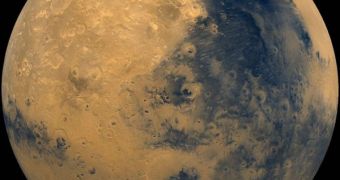Since the existence of water-ice at the Martian poles was confirmed, experts have been thinking of ways of exploiting this resource for space exploration. Now, it would seem that this no longer needs astronauts to land at the planet's poles, as water-ice was discovered closer to the equator as well.
Until now, there was no evidence that water-ice existed anywhere else except the Martian ice sheets. Those locations were confirmed to contain the stuff by both the Mars Odyssey orbiter and the Phoenix Mars Lander, which touched down close to the North Pole.
Craters located close to the Red Planet's equator may also contain vast amounts of water ice, similar to how the deep, dark craters on the South Pole of the Moon contain the same chemical in vast amounts.
Future missions to our neighboring planet are already in the works, but any crew going to Mars will have to also rely on resources they find there, not just on the stuff they can carry with them.
Despite the size of a future spacecraft we may use to get there, space will always be an issue, especially considering that current engine technologies can only take explorers there in trips lasting up to a year.
As such, prospective crews would need to carry food and water with them in large amounts. If they want to explore the Red Planet, they could benefit from obtaining their water by processing the water-ice reserves there.
One added advantage would be that they will not be forced to land near any of the poles, where temperatures are very low, and insufficient solar power is available for solar panels.
Given the new discoveries, it's currently clear that they can land near the equator, where setting up and maintaining a base is easier. The data that confirmed the findings were produced by the NASA Mars Global Surveyor (MGO) and the Mars Reconnaissance Orbiter (MRO) spacecraft.
Using data collected by these instruments, Malin Space Science Systems planetary geologist David Shean was able to discover ice-rich material at no less than 38 craters in a single region located next to the planetary equator.
“It always amazes me that something like this could go unnoticed, even with hundreds of thousands of high-resolution images taken from orbit in the past 15 years. T suppose it is a testament to the fact that Mars is full of surprises,” the expert says.
“I've seen thousands of images that show apparently ice-rich material and associated features on the floor of midlatitude craters in both hemispheres on Mars. The big surprise came when I noticed the same material within a crater near the Martian equator,” he adds.
“A follow-up review of existing data revealed more of this material within nearby craters, and that's when I knew that I was on to something important,” he concludes, quoted by Space.

 14 DAY TRIAL //
14 DAY TRIAL //